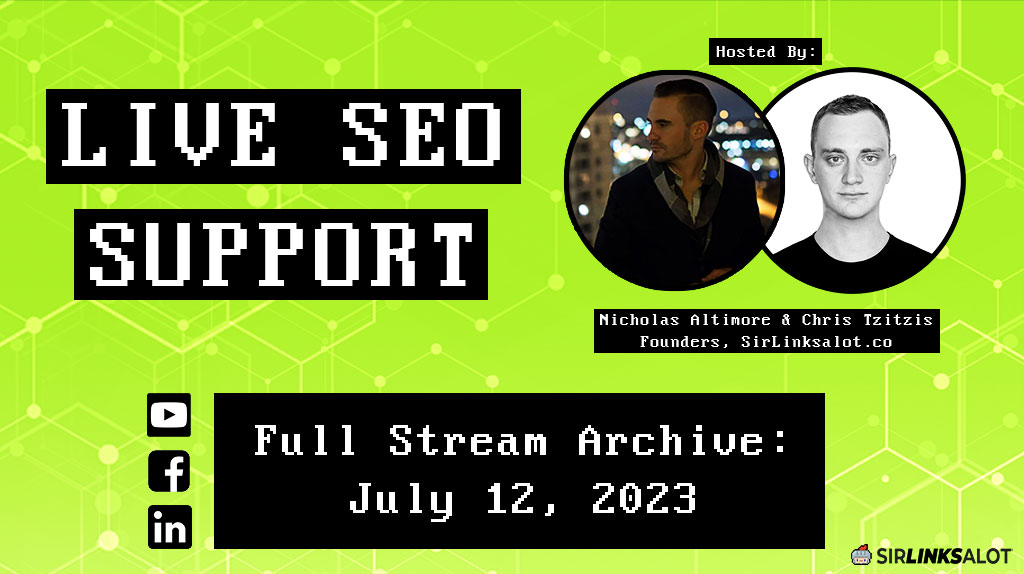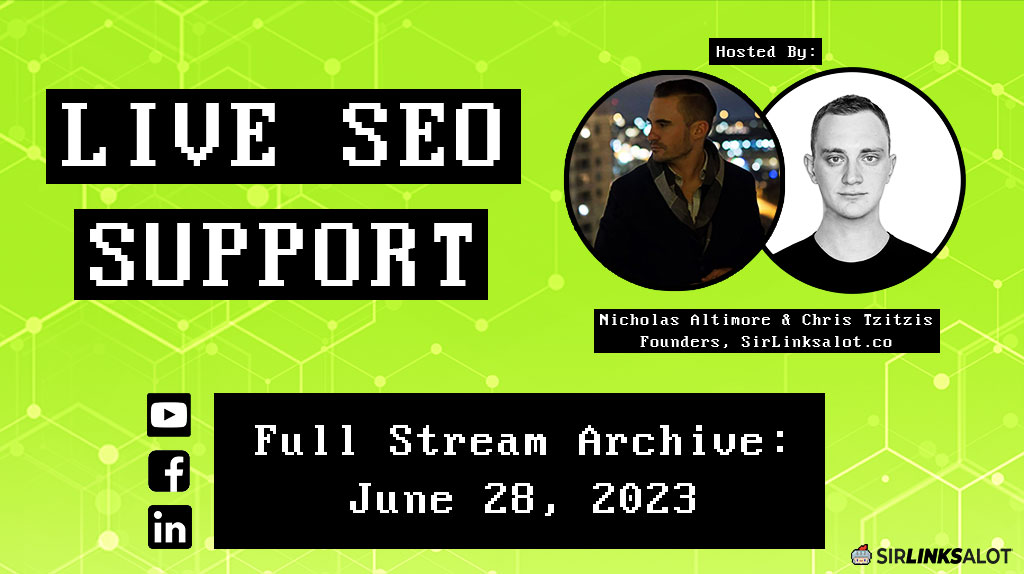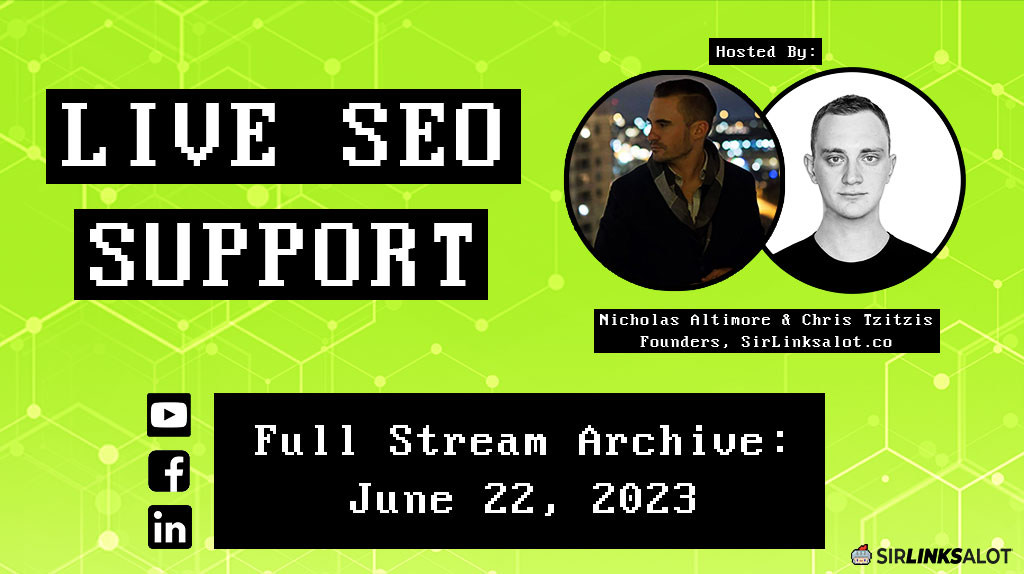Live SEO Support 9/15/21 – Full Episode
Join the 1,000+ brands that trust us for their link building.
Welcome to another episode of Live SEO Support!
Live SEO Support is an hour-long Weekly Livestream where our founders, Nicholas Altimore and Chris Tzitzis, take questions from the audience on anything related to SEO.
It’s 100% free, and anyone can join us weekly in our Facebook Group or on Youtube.
But in case you missed us live this week, here’s the full episode:
This Week’s Archived Livestream:
Summary:
[22:05] Does your business offer full link audits?
Unfortunately, we do not offer this full service yet (but we’ve talked about it a lot). Our Managed Link Building Program does deliver a basic audit with some information to the client as part of a monthly report, but other information regarding the site is kept private for internal analysis. This is because the MLB program is primarily a link building service and not a full site audit.
So technically, we do offer some form of backlink audit upon application to the MLB program — just don’t expect it to be in-depth/comprehensive. A downloadable sample report can be found at the link provided above. And to be frank, it’s unlikely that we will offer a comprehensive link audit service in the near future. We have a lot of ideas in the pipeline and that service would not take priority over other potential services.
[26:34] Is the Managed Link Building Program a minimum of $500 per month?
Yes, the MLB Program is a minimum of $500 per month (see link to MLB Program above for terms of service). That $500 minimum goes directly towards your backlinks every month, which we choose for you depending on the strategy.
Heads up: there may be a price increase on the MLB program in the future for new applicants. This is because our MLB Program, thanks to all of our followers, is growing fast and we might have to consider bringing on additional talent. Moreover, it’s a service that is quite difficult to automate.
[28:16] I have a site where the top page gets 40% of web traffic. I see this as a risk. How do I mitigate this problem?
We don’t see this as a risk in terms of Google penalties or making your website look weird and unnatural. In fact, we have several websites where most of the traffic comes from 1 or 2 pages. However, having a single web page hogging all the traffic can become a liability if there is a chance you drop out of the rankings for that specific page and its search term(s). Then you may be in a situation where you’re not making profit. This is basically a case of a lack of diversification and having all your eggs in one basket.
So how do you mitigate this risk? Create more content and target more terms. This will allow you to acquire multiple traffic sources.
But having 40% of traffic go to one page / keyword is a sign that you have niched-down very well. You should also try to see how you can capitalize on other related keywords (using more pages). This will also build Relevance across your domain.
In closing, don’t worry too much about this issue. You’re in a good position and it’s not really a problem. It’s more of an opportunity.
[32:22] How accurate is link detecting software such as Linquidator? It told me that a website had 40% spam links, but it hasn’t used any PBNs.
Link detecting software basically tries to detect and remove bad links. We don’t use this type of software because we like to do manual SEO analysis with tools like Ahrefs, SEMRush, or Majestic whenever possible (particularly for backlink profile analysis). Having said that, we don’t think there is anything wrong with using link detecting software. If any of our followers use software like this, feel free to post a comment about it in our FB group, the SEO Roundtable
We don’t really look at metrics like a “spam score”. In fact, we rarely ever remove bad links from our own website if we discover them. That’s because our complete backlink profile is strong and the other quality backlinks we build offset any negative from the few toxic links. Remember that it’s natural for any website to get bad links.
[42:23] Do you have tutorials on the perfect way to build a site using SirLinksalot?
No, we don’t have any specific, comprehensive tutorials like that. But we have plenty of free informational content on our website and Live SEO Support videos that will definitely teach you everything you need to know and more.
This is a big question, but each of us will try to provide a very simple blueprint here (assuming you are new to SEO and building a fresh site):
Nick:
- Start with good content based around solid keyword research.
- Throw in Pillow Links with natural anchors (mostly to the homepage).
- Sprinkle in some Authority Links like guest posts, niche edits, editorial links (either in the beginning or after the Pillow Links have resonated).
- Use a tool like Ahrefs to track the progress of your site as you are building it out.
- Add more content.
- Start being more aggressive with high-quality Authority Links.
Chris:
- Add lots of content based on keyword research (10 – 20 pages if possible).
- Create social profiles, citations and other relevant Pillow Links that every new website / company should have in the beginning.
- Start targeting your homepage with link diversity using backlinks like the ones provided by our Pillow Links, Diversity Links, Citations, Social Signals packs (natural white-hat links). During Month 1, you can also deploy a handful of Authority Links (niche edits, guest posts), but only to your homepage (using natural, branded, URL, generic anchors).
- After Month 1, be patient and track your progress (because it will take awhile for a brand new site to resonate in the SERPs). Keep adding more links to strengthen and diversify your backlink profile.
Ultimately, there is no perfect way to build a site or run a link building campaign.
[1:07:54] Can you explain PBNs in their simplest form (or do you have videos). I’m not quite sure how they work.
Here is a simple and practical explanation for what a PBN is:
A PBN is a Private Blog Network, which is pretty much self-explanatory — a group of simple websites / blogs (used for a specific purpose). Each asset / element in the PBN is an expired or auction-purchased domain that is used to build a website / blog. The domain has already been used and it has an existing backlink profile.
The new website is typically niched-down or re-themed depending on its niche. For example, the original domain was a general technology blog and the new website is niched-down to focus on PC games.
Each of the most important / powerful pages on the old site are rebuilt or repurposed (this can include 301 redirects for unused pages). The idea is to capture all of the old Link Juice from the old domain and redirect it to specific targets of your choosing (e.g. Money Sites and other projects you’re working on).
In the past, it was really easy to manipulate PBNs by creating low-quality pages and content (e.g. spun content) and still generate Power that can be directed to target sites. Obviously, Google caught on and you cannot get away with low-quality crap anymore (or the risk of de-indexation is high). That’s why we use high-quality PBNs, with original content, that function like real websites that resonate with Google.
[1:16:08] One of my sites had a couple of big money posts that were on Page 1, making me $3000 / month, but are now on Page 3. I’ve added more content to them but they still haven’t moved up in ranking. Can I blast them with backlinks instead?
It depends on how many backlinks you already have going to these money pages. In general you don’t want to carelessly overload them, or your homepage, with more links (as this can look unnatural). Always consider the # of backlinks to any inner page relative to the entire domain. It’s not best practice to have 1 or 2 inner pages receiving 25% of backlinks when you have dozens / hundreds of other pages, for example (or if you don’t have a lot of total referring domains). Even though this happens naturally sometimes, it can also appear manipulative.
Best practice would be to keep linking to your homepage (but don’t go wild). Also, look at your competitors in the SERPs and try to figure out why you fell off Page 1.
[1:20:30] Is content frequency important? What do you recommend (3 times per week)?
As much as you can feasibly publish. The more, the better. Basically, the amount of content will depend on the scope of your project and / or size of your budget. Also, look at your competitors and see how much content they have.
[1:25:14] When buying auction domains from different vendors, you never have the option to choose a registrant profile, so the domain will be registered on the company / profile that the account has. Then when the domain registration is complete after auction, you can change to privacy / change name etc.
But in WhoIs history there will be an instance where the company name / actual owner is shown, before swapping to privacy / fake name. Do you have a solution for this in SirLinksalot PBN strategy, or do you ignore this? Have you heard of a manual review / de-indexing based on historical WhoIs information?
Regarding WhoIs, you want to make sure you’re not running into footprints (especially when dealing with PBN building). Having said that, I don’t recall a time when I was specifically targeted with a de-indexation (other than the time there was a mass de-indexation and a lot of PBNs were hit). Now let’s say you are building a small PBN. Ideally, you want it to be dispersed across numerous registrars. However, there are some registrars that will give you Privacy for free or low cost (e.g. Namecheap). WhoIs is not 100% up to date at all times. You shouldn’t have to worry about this issue if you implement things fast enough.
Lastly, Google can only penalize you for some conceptualized footprint if they have concrete evidence of foul play (i.e. manipulating their search engine).
[1:31:00] Do you re-theme a PBN niche to fit your target site?
Yes, you can if you want to. You could probably find some obvious relationship between the marketing and health niches. You could even combine them in your PBN. Also, sites can link to each other naturally even if they are unrelated.
[1:33:08] How do you test a PBN?
Nick:
I do not test PBNs. I feel that I’m proficient enough at buying domains that I can make a proper assessment before making the purchase. I make sure it checks all the boxes and can be used for my specific purpose. I always look over the backlinks, footprint, and history. Honestly, it’s all intuition for me at this point. I don’t see the value in testing it after I have purchased and repurposed it for my goals.
[1:36:50] How many OBL (Outbound Links) per PBN should I have? I tend to link to a money site (1 PBN per money site?)
Always try to look natural, meaning don’t have, for example, 5 PBNs pointing to the same money site with only 1 OBL for each. Try to include a little diversity in your PBNs too, such as including an outbound authority link to another relevant domain. Some of the PBNs we use have 15 – 20 outbound authority links on the homepage. Basically, websites don’t link out to just one website (it’s not natural).
 Article by:
Article by:
Chris Tzitzis
Hey I'm Chris, one of the founders here at SirLinksalot. I'm into building internet money machines (affiliate websites) and specialize in building backlinks. Find out more about me and my link building team.
 Questions or Comments?
Questions or Comments?
We are active in our Facebook Group seven days a week and would love to hear from you. Ask us questions, learn from other group members, and share your knowledge.
Related Posts
Ready To Start Building Your Rankings?
Your link building journey to the top of Google starts today!
Apply for Managed Link Building to get a free analysis and game plan, or order backlinks a la carte.
Link building services that work.


